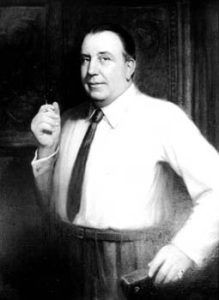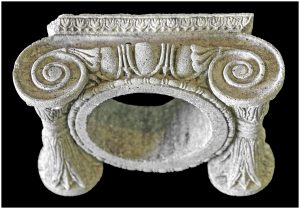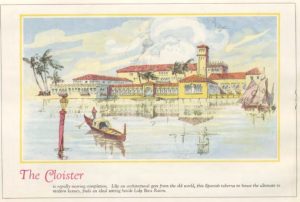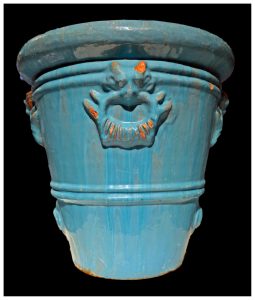
A current exhibit at The Schmidt Boca Raton History Museum coincides with the city of Boca Raton’s centennial and looks back on the continuing impact of city planner, industrialist and architect Addison Mizner.
The multimedia exhibit, Boca Raton 1925-2025: Addison Mizner’s Legacy, features photographs, drawings, maps and videos, and runs through May 30.
Highlighting Boca Raton’s past century of development from its beginnings as a rural agriculture stop on Henry Flagler’s East Coast Railroad, to a wealthy enclave and resort destination, is due in large part to the architectural philosophy and vision of Mizner.
“Contemplating the previous decades of progress gives us the foundation, perspective, and inspiration to make the next century even greater than Addison Mizner could have ever imagined,” says Mary Csar, executive director of the Boca Raton Historical Society.
Along with the museum’s curator, Susan Gillis, the exhibit was guest curated by architectural historian, and photographer Augustus Mayhew, author of Addison Mizner: A Palm Beach Memoir.
As a young man, Mizner traveled extensively in Spain, Mexico and Central America, visiting Guatemala, Costa Rica and Nicaragua, and was influenced by the architectural styles he saw there.
“I have based my design largely on the old architecture of Spain — with important modifications and to meet Florida conditions,” he said at the time.
His vision for both Palm Beach and Boca Raton included a city inspired by the style of Old-World Spanish or Italian towns — Mediterranean Revival and Spanish Colonial Revival styles — but with modern conveniences such as plumbing, roads and electricity.

According to Gillis, who has written eight books on local history, including Boomtime Boca: Boca Raton in the 1920s, Mizner would fly potential investors down from Palm Beach to Boca Raton in a seaplane.
In its archives, The Boca Raton Historical Society has hundreds of Mizner’s full-size promotional newspaper ads from all over the country advertising, “Where promises are as good as the God-given soil.”
“Nobody did PR better than Addison Mizner,” says Gillis, noting that Mizner, the best-known American architect of his era, was “incredibly ambitious.”
Her favorite ad was one promoting the Boca Raton Resort, boasting, “I am the greatest resort in the world; I am Boca Raton, Florida.” In small print were the words, “a few years hence.”
Mizner’s first Florida building in 1918 — now the Everglades Club — revolutionized staid Palm Beach, which had wooden homes mostly in the style of the Northeast, with its signature pink stucco, arched arcades, ornate wrought-iron balconies and terra-cotta tile roofs, which he himself manufactured at Mizner Industries on Bunker Road in West Palm Beach.
He designed the club as a commission for his friend and business partner Paris Singer, an heir to the Singer Sewing Machine Company, and the Singer for whom Singer Island is named. In addition to floor and roof tiles, the company manufactured pottery, period furniture, wicker, antique millwork, hardware and stained glass windows and doors.
From 1919 to 1924, Mizner designed approximately 38 houses in Palm Beach and homes in Boca Raton in the Old Floresta and Spanish Village residential neighborhoods and even the City Hall building, which now houses the Boca Raton History Museum.
The Addison, built in 1925, and now an event space on East Camino Real, was Mizner’s headquarters and administration building. According to Gillis, Mizner had an apartment on the second floor, a space now used for storage.
“I never begin to design a home without first imagining some sort of romance about it. Once I have my story, then the plans take place easily,” he said then.
Mizner had an apartment on Worth Avenue across from the Everglades Club, and his Palm Beach home, El Solano, at 720 S. Ocean Blvd., was built in 1925 and later purchased by Harold Vanderbilt, then John Lennon.
He had a roster of wealthy and high society clients including Rodman Wanamaker, Gurnee Munn, John Shaffer Phipps, Barclay Harding Warburton II, Anthony Joseph Drexel Biddle Jr., and Eva Stotesbury, among others.
In large part due to Mizner and his efforts, by 1925 Palm Beach was on the map as the premier resort destination in the U.S.

The centerpiece of the Boca exhibit is Mizner’s famed 1925 Mediterranean Revival-style Cloister Inn, now The Boca Raton. His signature details are evident in the resort’s red tile roofs, stucco exterior, lush, tropical landscaping, ornate lobbies and open air spaces as well as its opulent décor, some of which he manufactured himself.
On display at the museum are remnants of the original wrought-iron gate from the resort as well as a wrought-iron candelabra and jardinière, interior décor and vases and Ali Baba jars with his signature “Mizner blue” glaze and samples of tiles fabricated in his Las Manos Pottery company.
Also showcased are a selection of Mizner-designed architectural elements such as Corinthian column artifacts, casts-stone elements, fireplace mantels, decorative accessories and furnishings on loan from the Frederick Herpel Collection.
Unfortunately, by 1926, with the 1929 financial crisis looming and the South Florida land boom going bust, Mizner’s fortunes suffered a reversal. He lost financing and filed for bankruptcy. Many of his projects, including his vision of Boca Raton with a palm-tree lined boulevard and a grand canal reminiscent of the Canal do Mangue in Rio de Janeiro, went unrealized.
A painting of Mizner by Richard Reddington on the cover of his first (1925) brochure promoting this vision is on display at the exhibit. He leaves us with his prescient words:
“It is my plan to create a city that is direct and simple,” he said. “To leave out all that is ugly, to eliminate the unnecessary, and to give Florida and the nation a resort city as perfect as study and ideals can make it.”

Sadly, the architect who left his name and legacy in our city, died of heart disease a few years later in 1933 at the age of 60.
“I would love to have met him,” says Gillis. “Addison Mizner was a bon vivant who traveled the world and chose to make his mark right here in Palm Beach County. He lived a good and colorful life.”
What does Gillis think Mizner would think of Boca Raton now?
“He’d absolutely love it,” she says. “He’s still floating around in the ether today.”
“He’d love that buildings and resorts and golf and tennis clubs and whole areas of the city are named for him,” Gillis says. “His architectural style still has influence today, and, not just the style, but his glorious dream.”
The exhibit is on view 10 a.m. to 4 p.m. Wednesdays through Saturdays at the museum, 71 N. Federal Highway, through May 30. Admission is $12 for adults; and $8 for seniors age 65 and older and students age 5 and older. For more information, call 561-395-6766 or visit www.BocaHistory.org.